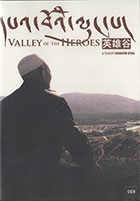
Valley of the Heroes 2013
Distributed by Documentary Educational Resources, 101 Morse Street, Watertown, MA 02472; 617-926-0491
Produced by Khashem Gyal
Directed by Khashem Gyal
DVD, color, 54 min.
Middle School - General Adult
Tibet, China, Language
Date Entered: 07/15/2016
Reviewed by Christopher Lewis, American University Library, American UniversityHualong County in Qinghai Province on the eastern edge of the Tibetan Plateau is described in this film as an area of Tibetan culture most vulnerable to the encroachment of Chinese culture, most pronounced in the disappearance of the Tibetan Language among all but the oldest residents.
The film was shot in Chukhor Village where old ways and new co-exist. There are cars and the children seem to be culturally modern, riding bicycles, fooling around, and savvy about cameras and TV. The interviews are primarily with elders who grew up speaking Tibetan and witnessed the steady change that began with the rule of General Ma Bufang, a Chinese Muslim warlord who served under Chiang Kai-shek in the 1930s-40s. It was under Ma Bufang when many Tibetans were massacred, Buddhist monasteries were destroyed, Chinese citizens were given houses and acreage in the Tibetan Plateau, and Tibetans were forced to intermarry with the Chinese. It was his influence on the region that also effected a substantial conversion of the native population to Islam. Following the Chinese Civil War and the establishment of the People’s Republic of China, the oppression of the Tibetan people continued during the Cultural Revolution. Today, the Chinese presence is so dominant that the Tibetan language is no longer taught in the schools and young Tibetans have come to regard Chinese as the practical and preferred language.
The political history behind China’s occupation of Greater Tibet including the period of Ma Bufang’s rule is complex and spans centuries and it isn’t adequately summarized in the video so the viewer will need to come to the work with some knowledge of this history or will benefit from doing additional research to put the story in context. It is ironic that while Ma Bufang systematically suppressed the ethnic Tibetan population of Qinghai, the survivors of that era who are fighting to keep the Tibetan culture alive, are Muslim converts and the mosques are where the aging community meets to speak Tibetan and carry on older traditions.
There is no doubt a fascinating story to be told about the Tibetan Plateau and the tragic history of the Tibetan people but unfortunately this video doesn’t rise to that level. It does give some insight into the efforts the Tibetan people are making to stave off extinction of their culture though. Additionally, Tibet has a symbolic meaning for Westerners, in no small part due to a growing interest in Buddhism and the Dalai Lama, and will likely be of interest among followers as well as socio-linguists and sociologists, so the video is recommended with reservations as an addition to the canon of knowledge on this region.